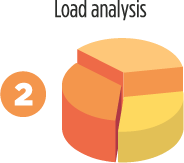Solar battery systems are elegantly simple in concept but sophisticated in their operation:
- Energy Collection: Your solar panels generate electricity during daylight hours
- Power Distribution: This electricity powers your home or business directly
- Energy Storage: Excess energy fills up your battery for later use
- Nighttime/Outage Power: Stored energy powers your home when solar panels aren’t producing
- Grid Independence: Reduce or eliminate your reliance on utility power
During a power outage, your battery system seamlessly activates, allowing you to keep critical systems running without interruption. Your refrigerator stays cold, lights remain on, and essential medical equipment continues to function—all powered by energy you’ve harvested from the sun.
Types of Solar Batteries: Finding the Right Solution
Not all solar batteries are created equal. Each technology offers different benefits that might make it more suitable for your specific needs:
Lithium-ion (Li-ion)
Advantages:
- Higher depth of discharge (use more stored energy without reducing cycle life)
- Longer lifespan due to higher cycle life
- Higher energy density (smaller size and weight)
- Higher round trip efficiency (less energy wasted)
- Virtually maintenance-free
- Fast charging rates
While more expensive than lead-acid options, lithium-ion batteries have become the standard for most residential and commercial applications due to their superior performance and longevity.
Lithium Iron Phosphate (LFP)
Advantages:
- More thermally and chemically stable than standard lithium-ion
- Enhanced safety profile (reduced fire risk)
- Does not contain nickel or cobalt (better environmental and ethical profile)
- Higher peak power ratings
- Even longer life than standard Li-ion
- No maintenance required
LFP batteries represent the premium tier of lithium battery technology, offering the ultimate in safety and longevity for those wanting the best possible solar storage solution.
Partial Charge Carbon (AGM)
Advantages:
- More efficient than traditional lead-acid batteries
- Greater lifespan and cycle life than flooded lead-acid
- Charges approximately 5 times faster
- Higher charging efficiency
- Minimal maintenance required
- No watering or off-gassing
AGM batteries provide a middle ground between traditional lead-acid and lithium technologies, offering improved performance at a more accessible price point.
Sealed Lead Acid Battery (Gel)
Advantages:
- More affordable than lithium options
- Less maintenance than flooded lead-acid
- Considered safer than traditional lead-acid
- Better heat tolerance than AGM batteries
- No watering required
Gel batteries are a good option for specific applications where cost is a primary concern and the batteries won’t need frequent deep cycling.
Flooded (Wet) Lead Acid Battery
Advantages:
- Lowest initial cost of all battery types
- Tried and true technology with over 115 years of commercial use
- Highly recyclable
- Well-understood technology
While requiring more maintenance and offering less depth of discharge, flooded lead-acid batteries remain a viable option for some backup power applications where budget constraints are significant.
Battery Backup Benefits During Power Outages
In Western North Carolina and Upstate South Carolina, power outages are an unfortunate reality. Summer thunderstorms and winter ice events can leave homes without power for hours or even days. A solar battery system provides critical protection:
- Immediate Response: Battery backup activates within milliseconds of a power outage
- Critical Load Support: Keep essential systems running (refrigeration, medical equipment, heating/cooling, well pumps, lighting)
- Peace of Mind: Eliminate the stress and disruption of unexpected outages
- Weather Independence: Maintain comfort and safety regardless of external conditions
- Extended Outage Protection: Depending on your system size and energy usage, batteries can provide power for days
After Hurricane Helene devastated Western NC in 2024, Sundance assisted Footprint Project in deploying mobile solar power systems to affected communities, demonstrating the critical role of solar + storage in disaster resilience.
The Duke Energy PowerPair Incentive Program
Duke Energy’s PowerPair program represents an unprecedented opportunity for homeowners to add battery storage at a significantly reduced cost:
- Direct Incentive: Up to $9,000 paid directly to offset battery installation costs
- No Complex Applications: Sundance handles all paperwork and program requirements
- Combined Savings: When paired with the 30% federal tax credit, savings can exceed 50%
- Limited Availability: Don’t miss this opportunity to maximize your savings
Our Renewable Energy Consultants can provide complete details on how to maximize your PowerPair incentives based on your specific situation.
Cost Savings with Battery Storage
Beyond the immediate incentives, battery storage delivers ongoing financial benefits:
- Peak Shaving: Avoid using expensive grid electricity during high-rate periods
- Self-Consumption Optimization: Use more of the solar energy you produce rather than selling it back to the grid at lower rates
- Demand Charge Reduction: Commercial customers can significantly reduce demand charges
- Rate Arbitrage: Charge batteries when electricity is cheap, use stored power when rates are high
- Extended Solar System Value: Maximize the financial return of your solar investment
- Increased Property Value: Homes with battery storage command premium pricing in today’s market
Depending on your energy usage patterns and local utility rates, the cost savings from battery storage can deliver an attractive return on investment beyond the basic backup power benefits.
Maintenance Requirements for Battery Systems
One of the most appealing aspects of modern battery storage is the minimal maintenance required:
Lithium-based Systems (Li-ion and LFP)
- Virtually maintenance-free
- No water levels to check
- No equalization charges needed
- Simple monitoring via smartphone apps or web portals
- Expected lifespan of 10-15+ years with minimal degradation
AGM and Sealed Lead-Acid
- No watering required
- Periodic visual inspection recommended
- Monitoring of charge levels advised
- Expected lifespan of 5-7 years with proper care
Flooded Lead-Acid
- Regular water level checks required
- Periodic equalization charging needed
- Terminal cleaning to prevent corrosion
- Expected lifespan of 3-5 years with diligent maintenance
At Sundance Power, we offer Performance Maintenance Agreements to ensure your entire solar + storage system operates at peak efficiency year after year.
Key Specifications to Consider When Choosing a Battery System
When evaluating battery options, these specifications help determine which system best meets your needs:
- Capacity: The total amount of energy the battery can store (measured in kilowatt-hours or kWh)
- Power Rating: How much electricity can be delivered at one time (measured in kilowatts or kW)
- Depth of Discharge (DoD): The percentage of battery capacity that can be safely used
- Round Trip Efficiency: The ratio of energy put into storage versus what can be retrieved
- Cycle Life: How many charge/discharge cycles the battery can deliver before significant degradation
- Peak Power: The maximum power output available for short periods (important for starting motors)
- Warranty Terms: Look for both year coverage and guaranteed capacity retention
Our Renewable Energy Consultants will help you navigate these specifications to find the perfect battery solution for your specific needs.
Expert Design and Installation Makes the Difference
At Sundance Power Systems, we’ve been designing and installing battery systems since our founding in 1995. Our experienced team follows a proven 5-step design process to create the optimal battery storage solution for your home or business:
- Site Visit: We assess your property and energy needs
- Load Analysis: We determine which systems are most important to back up
- Preliminary Design: We create a custom battery solution
- Design Review: We refine the system based on your feedback
- Final Proposal: We present a complete system design with clear pricing
This methodical approach ensures your battery system is properly sized and configured to meet your specific goals, whether that’s occasional backup power, daily cycling for self-consumption, or complete energy independence.
Ready to Explore Solar Battery Storage?
The experts at Sundance Power Systems are ready to guide you through the options and design a battery storage system that meets your energy needs and budget. With the current incentives from Duke Energy and the federal government, there’s never been a better time to add battery storage to your home or business.
Contact us today at www.SundancePower.com or (828) 645-2080 or get a quote online to begin your journey to energy independence with solar battery storage.
Sundance Power Systems has been empowering Western North Carolina and Upstate South Carolina with solar and battery solutions since 1995. As the region’s most experienced solar company, we bring unmatched expertise to every project, from design through installation and ongoing support.












